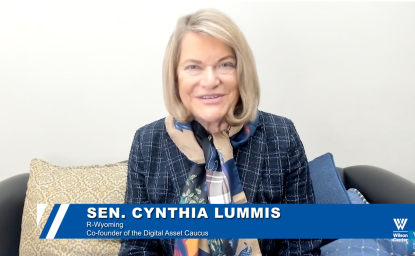Introduction
Crypto, in many ways, is in its adolescent phase. Just like an adolescent, as the underlying technology of crypto matures, so does its complexity. While 2022 saw a litany of meltdowns from centralized crypto entities like FTX, Celsius, and Three Arrows Capital, Decentralized Finance (DeFi) continued operating as designed. The irrational exuberance and inflated valuations of the 2019-2022 bull run have faded but the builders have remained, and DeFi continues to innovate.
With a market cap larger than the next 46 cryptocurrencies combined ($526B), relatively stable popularity, high level of decentralization and security, one would assume that the majority of DeFi happens on Bitcoin. However, Bitcoin's lack of smart contracts severely hinders its potential to be leveraged as a platform for DeFi. This is more the exception than it is the rule, as the majority of blockchains are smart contract compatible.
While there are now hundreds of smart contract-compatible blockchains, the overwhelming majority of DeFi occurs on Ethereum. Ethereum is the most mature and battle-tested smart contract-compatible blockchain and, as a result, is the 2nd largest cryptocurrency by market cap ($198B). Despite the relative security and stability of DeFi on Ethereum, adoption has been hindered by a lack of scalability and prohibitive transaction costs.
These bottlenecks are quickly beginning to disappear. Layer 2 blockchains built on top of Ethereum, like Arbitrum and Optimism, have transaction fees a fraction of the cost of Ethereum Layer 1. Additionally, upcoming Ethereum Layer 1 upgrades will allow Ethereum to scale to over 100,000 TPS (transactions processed per second). With the advent of these new features and systems, cost and scalability will no longer be a barrier to entry.
Now, if this all sounds exciting, but you find yourself wondering, “How does DeFi even work?”, you have come to the right place.
By the end of this article, you will have a better understanding of DeFi's core tenets, benefits & risks, and unique use cases. Most importantly, we will extract the key takeaways for policymakers who face the challenge of adapting regulation to this novel and decentralized financial landscape.
What is DeFi?
At a high level, Decentralized Finance, or DeFi, represents a new form of finance that leverages blockchain technology to create an open, transparent, and permissionless financial system. DeFi is not a singular entity, as it exists across hundreds of protocols on over 100 blockchains. DeFi is not controlled by any central authority; instead, it is governed by protocols and algorithms, making it accessible to anyone with an internet connection.
The Building Blocks of DeFi
To understand DeFi, it is helpful to understand some of its key components.
-
Coins and Tokens represent a wide range of digital assets and rights within the DeFi ecosystem. They can represent anything from a share in a liquidity pool, a currency for exchange, collateral for lending, representation of real-world assets, or voting rights in a DAO. While coin and token are often used interchangeably as both can be used similarly, they are meaningfully different in several ways.
-
Coin: A coin is a cryptocurrency that operates independently of any other platform. It has its own native blockchain where transactions occur. Coins are often used in the same way as physical currency: for buying and selling goods or services or as a store of value. Examples of coins include Bitcoin ($BTC), Ethereum ($ETH), and XRP ($XRP).
-
Token: On the other hand, a token is a cryptocurrency built on top of another blockchain. Tokens can represent a wide variety of assets or utilities. This includes fungible tokens like the dollar-pegged stablecoin $USDC (with issuance across 50+ blockchains) and Uniswap ($UNI), the governance token of Uniswap as well as non-fungible tokens (NFTs) like NBA Top Shot on the Flow blockchain.
-
Oracles are third-party services that provide smart contracts with external data. This ranges from digital asset price feeds for cryptocurrencies and NFTs to real-world price feeds for commodities and interest rates. While large Decentralized Exchanges like Uniswap have developed in-house oracles, most protocols leverage a third-party oracle, with Chainlink being the dominant player. This concentration represents a potential single point of failure for hundreds of protocols. Oracles are a complex and integral part of many crypto protocols that we will cover in-depth in an upcoming article in the Blockchain Brief series.
-
Decentralized governance is another key aspect of DeFi. In traditional finance, decisions are made by a central authority. In DeFi, however, decisions are made collectively by the community. This is often facilitated through Decentralized Autonomous Organizations (DAOs), where token holders vote on proposals ranging from protocol upgrades to resource allocation. It's like a company where every shareholder has a say in decision-making at every step rather than waiting for quarterly or annual shareholder meetings.
-
Layer 2 Solutions: As mentioned earlier in this article, given the scalability issues with Ethereum, many DeFi projects are exploring Layer 2 solutions to address these challenges. A Layer 2 solution is essentially a secondary framework or protocol built on top of an existing blockchain (in this case, Ethereum's Layer 1). The primary purpose of these Layer 2 solutions is to offload some of the transactional load from the main chain, thereby improving transaction speeds and reducing costs. This allows for more scalability without compromising the security of the main blockchain. Delve deeper into the differences between Layer 1 and Layer 2 Ethereum in the Blockchain Brief Understanding Ethereum's Layer 1 and Layer 2: Differences, Adoption, and Drawbacks.
DeFi Use Cases
DeFi has several use cases that open up numerous opportunities for users to manage their digital assets, lend and borrow money, and make yield-generating investments without needing a centralized entity.
-
Decentralized Exchanges (DEXs): These platforms allow users to trade digital assets directly without a centralized authority. They can be automatic market makers (AMMs) like Uniswap or Curve or have a bid/ask system. Users provide liquidity. A liquidity pool is a smart contract that contains funds of the two tokens in the trading pair. For example, a liquidity pool for $UNI/$USDC would contain both $UNI and $USDC tokens. Users who provide liquidity then share a percentage of transaction fees charged by the DEX proportional to the amount of liquidity they have provided.
-
Open Lending Platforms: These decentralized applications (dApps) allow users to lend or borrow digital assets. Borrowers deposit collateral, which is sold to reimburse the lender if its value falls below a certain threshold. Without the need for credit checks and the permissionless nature of DeFi, the speed, and accessibility of collateralized lending are both significantly improved compared to traditional finance. Increasingly, DeFi protocols are beginning to allow the use of real world assets as DeFi loan collateral.
-
Stablecoins: These digital assets have their value pegged to another asset, such as a fiat currency, with the overwhelming majority pegged to the US dollar to reduce volatility. They are popular in the DeFi space due to their stability. Most trading pairs on both centralized (both domestic and abroad) and decentralized exchanges include a US dollar-denominated stablecoin.
-
Decentralized Insurance: Platforms like Nexus Mutual offer insurance against events like market crashes or hacks. The risk is shared among a pool of investors, and the payout terms are publicly visible.
-
Synthetic Asset Issuance: This involves creating a digital asset token that mimics the properties of another asset. These synthetic assets can represent almost anything, including simple assets like precious metals and other commodities, digital assets, or more complex financial instruments like stocks and derivatives. These synthetics can generally be bought, traded, and sold, allowing holders to gain exposure to previously illiquid or difficult-to-obtain assets.
-
Yield Farming: This involves locking digital assets on DeFi protocols in return for rewards, usually automatically delivered by a smart contract. However, it's considered high risk/reward due to highly variable interest rates and impermanent loss driven by market volatility.
-
Staking: This is a more straightforward DeFi use case where users participate in securing Proof-of-Stake (POS) blockchains by delegating or staking their assets directly with the protocols, which usually involves a lock-up period, earning rewards in return.
How Does DeFi Benefit Users?
DeFi applications democratize access to financial services by being open to anyone with an internet connection, regardless of their location or banking status. They offer transparency, security, and control over personal assets, reducing reliance on traditional financial intermediaries. With their programmability and interoperability, DeFi platforms foster innovation, efficiency, and inclusivity in the global financial system. While there is no central overarching authority, several key characteristics of DeFi designed to benefit users are shared across most protocols.
-
Open Access: DeFi applications are open to anyone with an internet connection. This is particularly important for unbanked or underbanked populations, who may not have access to traditional financial services.
-
Decentralization: DeFi applications are built on public blockchains, which are decentralized and distributed across a network of computers. This provides network stability and redundancy as transactions continue to process if nodes go down.
-
Self-Custody: In DeFi, users have full control over their assets. They can manage their own private keys and do not need to trust a third party to keep their assets safe.
-
Transparency: All transactions on the blockchain are transparent and can be audited by anyone. This transparency builds trust among users and reduces the risk of fraud and corruption.
-
Interoperability: DeFi applications are built on standards that allow different DeFi applications to work together, creating a more interconnected and efficient financial system.
-
Programmability: DeFi leverages the power of smart contracts, which are self-executing contracts with the terms of the agreement directly written into code. This automation eliminates the need for intermediaries and reduces the potential for human error or fraud in regard to contract terms. This in turn allows for the creation of complex financial instruments and services.
-
Trustless: DeFi transactions and agreements can be verified, monitored, and enforced without the need for a trusted third party or intermediary.
-
Permissionless: Anyone can create, use, or invest in a DeFi application or system without needing approval from a central authority. Anyone can create a liquidity pool, allowing for the quick creation of capital markets for smaller players innovating in the space, providing an equal playing field against incumbents.
-
Global Scope: DeFi applications can operate across borders, providing global access to financial services while reducing the friction inherent in the traditional financial system.
What’s the Catch?
DeFi has opened a new world of financial possibilities; however, it is a quickly evolving and complicated space. Crypto still has a long way to go on the ease-of-use front. As such, some of the theoretical benefits can quickly become liabilities if users are not careful. There are several risk factors to be aware of.
-
Smart Contract Vulnerabilities: While smart contracts operate on transparent and auditable code, having access to the code is very different from being able to interpret the code. If there are bugs or vulnerabilities in the code, it could be exploited by malicious actors, leading to loss of funds.
-
Price Volatility: Cryptocurrencies are known for their price volatility. This can be a risk, especially for those participating in DeFi protocols that involve collateral. If the value of the collateral drops significantly, it could lead to the liquidation of assets.
-
Impermanent Loss: This risk is associated with providing liquidity in DeFi protocols. Suppose the price of the tokens in the liquidity pool diverges significantly. In that case, the liquidity provider can suffer an impermanent loss, which becomes permanent if the liquidity is withdrawn during the price divergence.
-
Regulatory Risk: The regulatory environment for DeFi is still uncertain in many jurisdictions, particularly in the US. Changes in regulations or enforcement actions could impact the operation of DeFi protocols and the value of associated tokens.
-
Rug Pulls and Scams: In a rug pull, the developers of a DeFi project could suddenly withdraw all the funds from the project, leaving investors with worthless tokens. Scams are also prevalent in DeFi, with fraudsters creating fake projects to lure in unsuspecting investors.
-
Complexity and User Error: DeFi can be complex and challenging to understand, even for experienced users. One small mistake, like sending funds to the wrong address or interacting with the wrong smart contract, can lead to a total loss of funds. Additionally, in a decentralized system, there is no customer service or central authority to appeal to for a mistake to be rectified. Due to the immutable nature of the ledger, transactions cannot be reverted once confirmed.
-
Self-Custody: While there are clear benefits to users being able to self-custody, there are risks. If a user loses their crypto wallet's private keys or recovery phrase, there is no other means to recover access. It is estimated that around three million $BTC in dormant wallets, valued at $88.1B, belong to early adopters who lost access to their wallets.
It's essential for anyone getting involved in DeFi to understand these risks and take appropriate steps to mitigate them, such as doing thorough research, using trusted platforms, and not investing more than they can afford to lose.
Key Takeaways for US Policymakers
As we have seen, the DeFi landscape is complex, rapidly evolving, and presents significant opportunities and challenges. It is crucial for policymakers to understand these dynamics to create a regulatory environment that fosters innovation, protects consumers, and maintains the financial system's integrity. Here are some key takeaways for policymakers to consider.
-
Regulatory Clarity is Needed: The US regulatory environment for DeFi is currently uncertain. Clear and consistent regulations that protect consumers and promote innovation would allow innovators to operate with certainty and confidence. This will help to attract and retain talent and investment in the US, boosting innovation.
-
Consumer Education and Awareness: Given the complexity of DeFi, there is a need for education and awareness campaigns to ensure that users understand the risks and benefits. Policymakers can play a role in promoting such initiatives.
-
Regulating Decentralized Systems: Regulating DeFi is inherently challenging due to its decentralized structure. Traditional regulatory approaches designed for centralized entities may not be directly applicable to automated decentralized protocols. It's essential to remember that significant technological advancements, such as the development of digital public goods infrastructure like TCP/IP and SMTP for the Internet in the 90s, thrived under a light regulatory touch. Similarly, the burgeoning digital financial infrastructure might flourish best with minimal interference. While parallels exist with traditional finance, imposing old regulatory frameworks on this innovative asset class could hinder its growth.
It's crucial to highlight that the most significant financial disasters causing direct harm to consumers have been perpetrated by centralized, off-chain entities. Notable examples include entities like FTX and 3AC, which operated with a lack of transparency, obfuscating their questionable activities until they culminated in contagion-laden disasters. Overemphasizing the regulation of on-chain, decentralized entities might be placing too much emphasis on the wrong aspect, especially when the real threats have historically been centralized entities with opaque operations.
However, centralized exchanges and payment processors, which facilitate the movement of fiat currency into and out of DeFi, offer a more tangible point for enhanced transparency and oversight.
In conclusion, DeFi presents an opportunity for the US to lead in a new era of financial innovation. However, it also presents significant challenges that require thoughtful and informed policymaking. It's important to note that DeFi has the potential to complement and enhance the existing financial system; it doesn't necessarily need to replace it. Both systems can coexist, each serving different needs and markets. Therefore, regulations should be designed to allow for this coexistence, fostering an environment where traditional finance and DeFi can mutually benefit from each other's strengths. By understanding the dynamics of DeFi and taking a balanced approach to regulation, policymakers can help foster a vibrant and thriving DeFi ecosystem in the US.








